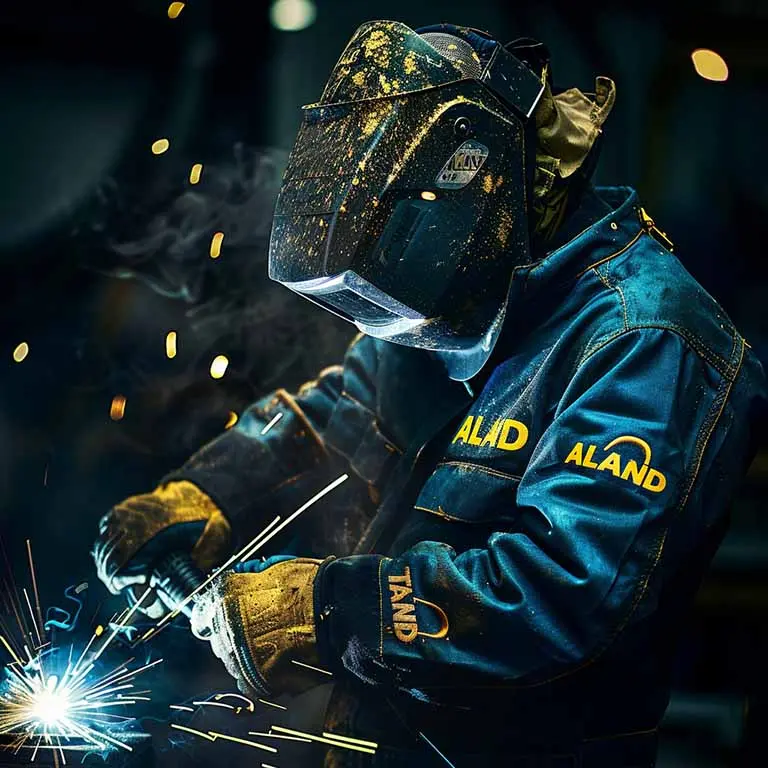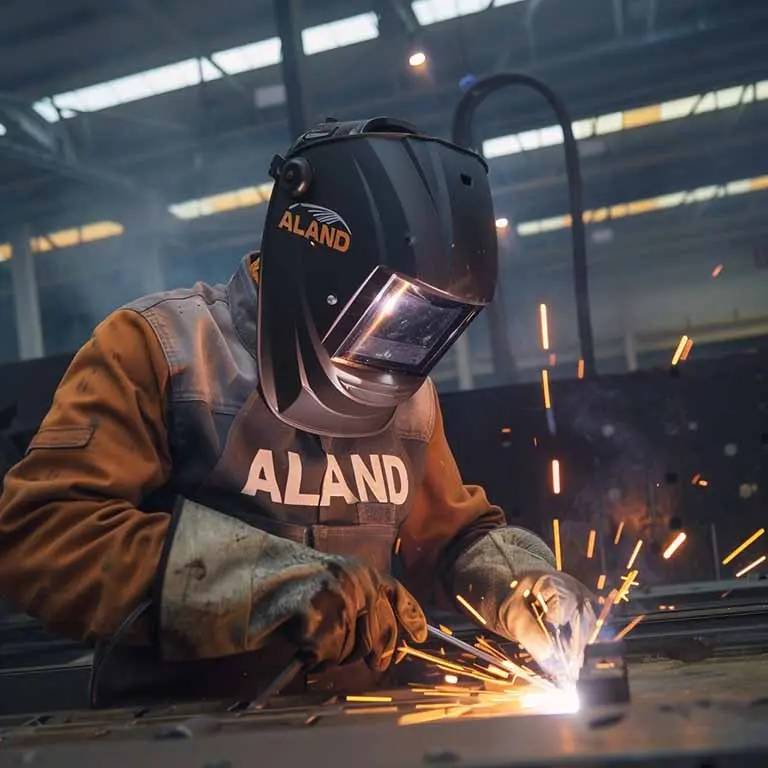Introduction to Double pulse welding technology

ALAND WELDING Let you feel the most sincere welding service

1. Introduction to double pulse welding
Double pulse welding is an advanced welding technology that uses two different current pulses to control the welding process to achieve more precise and controllable welding results. This technology is usually used to weld materials that require high strength and high quality, such as aluminum alloys, stainless steel, etc.
In double pulse welding, there is usually a main pulse and a secondary pulse. The main pulse is used to melt the welding material, and its energy is greater than the auxiliary pulse, thereby ensuring that the welding area is fully melted. The auxiliary pulse helps control the formation and transmission of droplets. By adjusting the parameters of the auxiliary pulse, the size, shape and transmission speed of the droplets can be affected, thereby affecting the formation of the weld.
2. Advantages of double pulse weld technology
(1) Precise heat control: Double pulse welding technology allows welders to more accurately adjust the heat input during the welding process. By controlling the parameters of the main and auxiliary pulses, such as current, frequency and width, the temperature distribution in the welding area can be precisely controlled. This precise thermal control helps reduce welding distortion and residual stress, improving the quality and stability of welded joints.
(2) Reduce welding defects: Double pulse welding technology helps reduce common defects during the welding process, such as pores, cracks and inclusions. By precisely controlling the heat input and droplet transfer during the welding process, more uniform and stable weld formation can be achieved, the occurrence of defects can be reduced, and the quality and reliability of welded joints can be improved.
(3) Wide range of applications: Double pulse technology is suitable for various types and thicknesses of metal materials, including aluminum alloys, stainless steel, nickel-based alloys, etc. Especially when welding highly reactive materials, double pulse welding technology can give full play to its advantages and achieve more stable and high-quality welding.
(4) Reduce spatter rate: Through the control of auxiliary pulses, double-pulse welding technology can effectively reduce spatter during the welding process. The auxiliary pulse helps control the formation and transmission of droplets, reduces the splashing and sputtering of droplets, and improves the stability and safety of the welding process.
(5) Improve production efficiency: Because double pulse welding technology can achieve more stable and high-quality welding, it can improve production efficiency. Reducing welding defects and the need for rework reduces scrap rates while improving welding speed and welding quality, thereby reducing production costs.

3. Disadvantages of double pulse welding technology
(1) Complex parameter settings and adjustments: Double-pulse welding technology involves the precise adjustment of multiple parameters, such as the current, frequency, width, etc. of the main pulse and auxiliary pulse. The setting of these parameters requires in-depth theoretical knowledge and rich practical experience, and welding operators must understand how these parameters affect the welding process and welding quality. Therefore, the threshold for learning and mastering double pulse welding technology is relatively high.
(2) Higher equipment cost: The welding equipment required for double pulse welding is usually more complex and more costly. This includes dual pulse welding power sources, control systems and corresponding welding guns and accessories. High equipment costs may limit the adoption of this technology by some businesses, especially small and medium-sized businesses or those with limited budgets.
(3) High technical requirements: Double pulse technology requires welding operators to have a high level of technology and professional knowledge. They need to be able to accurately understand the role of welding parameters and be able to adjust and optimize them according to actual conditions. This technically demanding feature may result in increased training costs for welding operators, or in some cases operational errors may occur that affect welding quality.
(4) High maintenance and upkeep costs: Double pulse equipment usually requires regular maintenance and upkeep to ensure its normal operation and stability. Due to the high complexity of the equipment, maintenance and upkeep costs may be relatively high. Additionally, if equipment fails or parts need to be replaced, additional repair costs and downtime may be added.
(5) Not suitable for all applications: Although double pulse welding technology is excellent in improving welding quality and stability, it is not suitable for all welding application scenarios. For some simple welding tasks or situations where welding quality is not high, the use of Double pulse technology may appear to be too complex and unnecessary, thus increasing production costs and complexity.
4. Metal welding materials suitable for double pulse welding technology
Double pulse welding technology is suitable for various types of metal materials, especially when welding materials with high strength and high quality requirements. Here are some common metal materials that Double pulse technology is suitable for:
(1) Aluminum alloy: Double pulse technology performs well in welding aluminum alloys. Aluminum alloy has high thermal conductivity and thermal expansion coefficient, so it is prone to deformation and cracks during welding. Double pulsetechnology can reduce welding heat input by precisely controlling welding parameters, thereby effectively reducing the risk of deformation and cracks.
(2) Stainless steel: Double pulse technology is also suitable for welding of highly corrosion-resistant metal materials such as stainless steel. Stainless steel usually has high hardness and corrosion resistance, so it is easy to produce welding defects such as pores and inclusions during the welding process. Double pulse technology can reduce the occurrence of these defects and improve welding quality through precise heat control and droplet transmission control.
(3) Nickel-based alloys: Nickel-based alloys are often used in high temperature and corrosive environments, such as turbine components in the aerospace field. Double-pulse technology can help reduce the generation of pores and inclusions when welding these high-temperature alloys, ensuring the quality and reliability of welded joints.
(4) Titanium alloy: Titanium alloy has excellent strength and corrosion resistance and is often used in aerospace and medical equipment and other fields. Double-pulse technology can effectively control the heat input and heat-affected zone during the welding process, reduce the generation of pores and cracks, and improve the quality of welded joints.

5. Double pulse industry
Double pulse welding technology is suitable for many welding industries, especially those that require higher welding quality and stability. The following are some of the main welding industries suitable for the application of dual pulse technology:
(1) Automobile manufacturing industry: The automobile manufacturing industry requires a large amount of welding of metal materials, including steel, aluminum alloys, etc. Double pulse technology can improve the quality and stability of welded joints, reduce welding defects, and achieve more efficient production in the automotive manufacturing industry.
(2) Aerospace industry: The aerospace industry has extremely high requirements for welding quality and reliability, because the quality of welded joints is directly related to flight safety. Double pulse weld technology can provide a higher level of welding quality and stability when welding aerospace components, reducing defective product rates and repair costs.
(3) Electronic equipment manufacturing industry: In the electronic equipment manufacturing industry, fine welding of various metal materials is usually required, such as welding electronic components, circuit boards, etc. Double pulse weld technology can provide a more precise and controllable welding process, suitable for small welding areas, resulting in high-quality welding.
(4) Shipbuilding industry: The shipbuilding industry requires the welding of large metal structures, such as steel plates, ship hulls, etc. Double pulse weld technology can improve welding quality and stability, reduce welding deformation and cracks, and ensure the firmness and safety of ship structures.
(5) Energy industry: The energy industry involves the welding of various metal pipes, containers, etc., such as petrochemical, nuclear energy and other fields. Double pulse weld technology can improve the sealing and corrosion resistance of welded joints and ensure the safe operation of pipelines and containers.
6. Precautions for double pulse
When using dual pulse welding technology, understanding the relevant precautions is critical to ensuring welding quality and safety. Here are some considerations for double pulse welding:
(1) Parameter setting: Double pulse weld technology requires precise parameter setting, including the current, frequency, pulse width, etc. of the main pulse and auxiliary pulse. Operators must be familiar with the setting methods of these parameters and adjust them according to material characteristics and welding requirements to ensure welding quality.
(2) Welding equipment maintenance: Double pulse weld equipment is relatively complex, and regular maintenance and upkeep are crucial. Operators should follow the equipment manufacturer’s recommendations to regularly inspect and maintain welding equipment to ensure proper operation.
(3) Welding safety: When using double pulse weld technology, operators should follow welding safety regulations and wear appropriate personal protective equipment (PPE), such as welding masks, gloves and protective clothing, to prevent splash and arc damage.
(4) Material preparation: Before welding, make sure the material surface is clean and free of oil, rust and other impurities. This helps reduce defects that may occur during the welding process, such as pores and inclusions, and improves the quality of welded joints.
(5) Welding environment: Ensure that the welding environment is well ventilated to avoid accumulation of smoke and gas generated by welding in the welding area. Double pulse weld technology may produce less spatter when welding, but should still ensure that the welding area is clean and safe.
(6) Welding technology training: Double pulse weld technology requires operators to have a high technical level. Ensure that welding personnel are properly trained and certified and are familiar with the operating methods and precautions of double pulse weld.
(7) Welding monitoring: When using double pulse welding technology, it is recommended to use welding monitoring equipment or systems to monitor the welding process in real time and ensure the accuracy and stability of welding parameters. This helps to promptly detect and correct problems during the welding process and ensure welding quality.
In summary, double pulse weld technology is a powerful welding method suitable for various metal materials and various industry sectors. It provides excellent stability and flexibility when welding products with high quality and high precision requirements. However, the correct application of this technology requires relevant technical knowledge and experience, as well as attention to its potential shortcomings and risks.
When using double pulse welding technology, you should ensure the correct maintenance of the equipment, precise setting of parameters, and the safety and cleanliness of the welding environment. In addition, technical training and welding monitoring are also important factors to ensure welding quality. By following these precautions, operators can take full advantage of dual-pulse welding technology and achieve high-quality, efficient welding production.
For the future, with the continuous development and improvement of welding technology, double pulse welding technology is expected to show its value in more industries and application scenarios. Through continuous improvement and technological innovation, welding quality will continue to improve, bringing greater production efficiency and product reliability to all walks of life.
